Related Research Articles
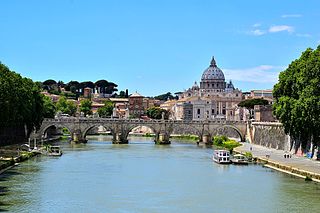
The Tiber is the third-longest river in Italy and the longest in Central Italy, rising in the Apennine Mountains in Emilia-Romagna and flowing 406 km (252 mi) through Tuscany, Umbria, and Lazio, where it is joined by the River Aniene, to the Tyrrhenian Sea, between Ostia and Fiumicino. It drains a basin estimated at 17,375 km2 (6,709 sq mi). The river has achieved lasting fame as the main watercourse of the city of Rome, which was founded on its eastern banks.

In ancient Roman religion and myth, Faunus[ˈfau̯nʊs] was the horned god of the forest, plains and fields; when he made cattle fertile he was called Inuus. He came to be equated in literature with the Greek god Pan.
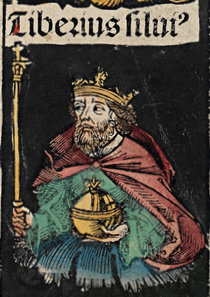
Tiberinus was the ninth king of Alba Longa, according to the traditional history of Rome handed down by Titus Livius. He was the successor of Capetus, the eighth king of Alba Longa. The Alban kings claimed descent from Aeneas, a Trojan prince who brought a remnant of the Trojan populace to Italy following the sack of Troy, and settled in Latium. Alba was built by Ascanius, the son of Aeneas and Lavinia, and founder of the Alban royal line. The Alban kings, including Tiberinus, bore the cognomenSilvius, after the son of Ascanius, who was said to have been born in the woods.
Vejovis or Vejove was a Roman god of Etruscan origins.

Acca Larentia or Acca Larentina was a mythical woman, later goddess of fertility, in Roman mythology whose festival, the Larentalia, was celebrated on December 23.

RheaSilvia, also known as Ilia was the mythical mother of the twins Romulus and Remus, who founded the city of Rome. Her story is told in the first book of Ab Urbe Condita Libri of Livy and in Cassius Dio's Roman History. The Legend of Rhea Silvia recounts how she was raped by Mars while she was a Vestal Virgin and as a result became the Mother of Romulus and Remus the founders of Rome. This event would be portrayed numerous times in Roman art while the story was mentioned both in the Aeneid, and in the works of Ovid. Modern academics consider both how Rhea Silvia is relevant for the treatment of rape victims in Roman mythology as well as the different ways she is portrayed in Roman art.
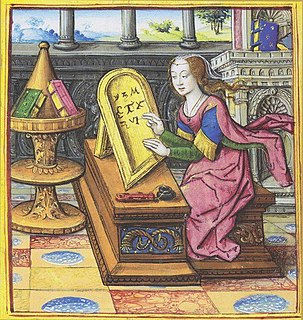
In ancient Roman religion and myth, Carmenta was a goddess of childbirth and prophecy, associated with technological innovation as well as the protection of mothers and children and a patron of midwives. She was also said to have invented the Latin alphabet.

In ancient Roman religion, the god Consus was the protector of grains. He was represented by a grain seed. His altar (ara) was located at the first meta of the Circus Maximus. It was either underground, or according to other sources, covered with earth, which was swept off during the two Consualia, his festivals on August 21 and December 15 and on July 7 when the pontiffs held a sacrifice there. He was thus a chthonic god. The Flamen Quirinalis and the Vestals officiated at his rites.
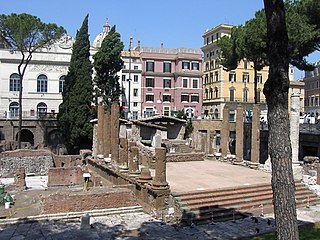
In the myth and religion of ancient Rome, Juturna, or Diuturna, was a goddess of fountains, wells and springs, and the mother of Fontus by Janus.

Fontus or Fons was a god of wells and springs in ancient Roman religion. A religious festival called the Fontinalia was held on October 13 in his honor. Throughout the city, fountains and wellheads were adorned with garlands.
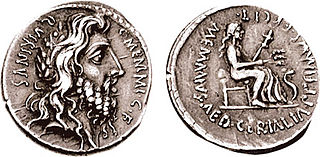
In Roman mythology and religion, Quirinus is an early god of the Roman state. In Augustan Rome, Quirinus was also an epithet of Janus, as Janus Quirinus.
Volturnalia was the Roman festival on August 27 dedicated to Volturnus, 'god of the waters,' god of fountains. Volturnus was a tribal river god who later was identified as god of the Tiber river. The Volturno River, in southern Italy, is named for him. Volturnus was the father of the goddess Juturna, who was first identified with a spring in Latium near the Numicus River and later with a pool near the Temple of Vesta in the Forum of Rome. They were both honored on this day with feasting, wine-drinking, and games.

Vatican Hill is a hill located across the Tiber river from the traditional seven hills of Rome, that also gave the name of Vatican City. It is the location of St. Peter's Basilica.

The College of Pontiffs was a body of the ancient Roman state whose members were the highest-ranking priests of the state religion. The college consisted of the Pontifex Maximus and the other pontifices, the Rex Sacrorum, the fifteen flamens, and the Vestals. The College of Pontiffs was one of the four major priestly colleges; originally their responsibility was limited to supervising both public and private sacrifices, but as time passed their responsibilities increased. The other colleges were the augurs, the quindecimviri sacris faciundis , and the Epulones.

A flamen was a priest of the ancient Roman religion who was assigned to one of eighteen deities with official cults during the Roman Republic. The most important of these were the three flamines maiores, who served the important Roman gods Jupiter, Mars, and Quirinus. The remaining twelve were the flamines minores. Two of the minores served deities whose names are now unknown; among the others are deities about whom little is known other than the name. During the Imperial era, the cult of a deified emperor also had a flamen.

In historiography, ancient Rome describes Roman civilization from the founding of the Italian city of Rome in the 8th century BC to the collapse of the Western Roman Empire in the 5th century AD, in turn encompassing the Roman Kingdom, Roman Republic and Roman Empire until the fall of the western empire. The civilisation began as an Italic settlement in the Italian Peninsula, traditionally dated to 753 BC, that grew into the city of Rome and which subsequently gave its name to the empire over which it ruled and to the widespread civilisation the empire developed. The civilization was led and ruled by the Romans, alternately considered an ethnic group or a nationality. The Roman Empire expanded to become one of the largest empires in the ancient world, still ruled from the city, with an estimated 50 to 90 million inhabitants and covering 5 million square kilometres at its height in AD 117.

Romulus was the legendary founder and first king of Rome. Various traditions attribute the establishment of many of Rome's oldest legal, political, religious, and social institutions to Romulus and his contemporaries. Although many of these traditions incorporate elements of folklore, and it is not clear to what extent a historical figure underlies the mythical Romulus, the events and institutions ascribed to him were central to the myths surrounding Rome's origins and cultural traditions.

In ancient Roman religion, the Flamen Quirinalis was the flamen or high priest of the god Quirinus. He was one of the three flamines maiores, third in order of importance after the Flamen Dialis and the Flamen Martialis. Like the other two high priests, he was subject to numerous ritual taboos, such as not being allowed to touch metal, ride a horse, or spend the night outside Rome. His wife functioned as an assistant priestess with the title Flaminicia Quirinalis.
References
- ↑ Campbell, Brian (2012). Rivers and the Power of Ancient Rome. Chapel Hill: The University of North Carolina Press. p. 141. ISBN 9780807869048.
- 1 2 Forsythe, Gary (2006). A critical history of early Rome : from prehistory to the First Punic War. Berkeley: University of California Press. p. 118. ISBN 9780520249912.
- ↑ Bunson, Matthew (2002). Encyclopedia of the Roman empire . New York: Facts On File. p. 589. ISBN 9781438110271.
- ↑ Oswalt, Sabine G; Cottrell, Leonard (1969). Concise encyclopedia of Greek and Roman mythology. Glasgow: Collins. p. 299. ISBN 978-0695861094.
- ↑ Adkins, Lesley; Adkins, Roy A. (2004). Handbook to life in ancient Rome . New York: Facts On File. p. 306. ISBN 9780816074822.
- ↑ Campbell, Brian (2012). Rivers and the Power of Ancient Rome. Chapel Hill: The University of North Carolina Press. p. 124. ISBN 9780807869048.
- ↑ Wiseman, T.P. (2004). The myths of Rome. Great Britain: University of Exeter, UK. p. 162. ISBN 9780859897037.